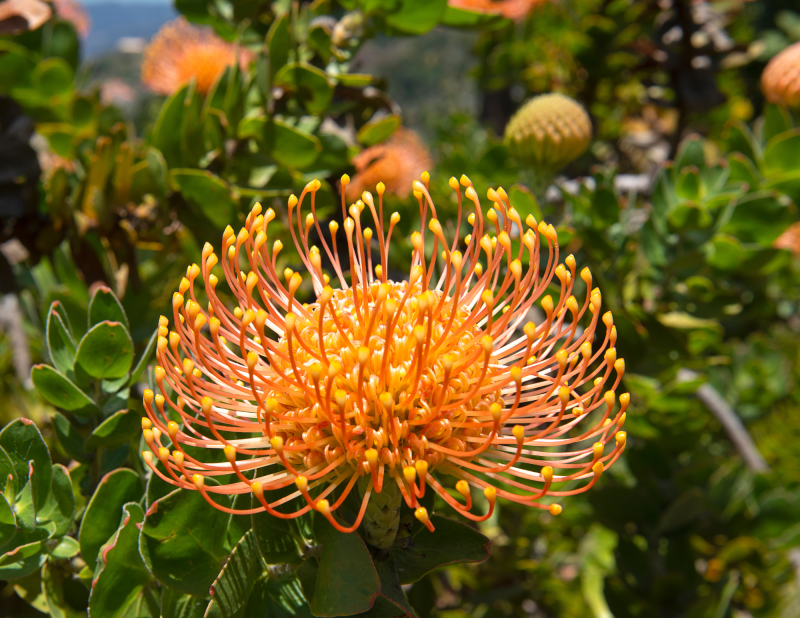I wouldn’t be surprised if you told me Leucospermum cordifolium (Nodding Pincushion) grew on Mars. The alien flower has a thick, rigid stalk supporting several tightly bound leaves. Atop is a spiny, golden crown — like stray hairs on a balding man’s scalp. A dandelion on steroids. You could’ve told me Leucospermum cordifolium swallowed the sun, and I would’ve believed you without hesitation. The flower demands a caution sign: Do Not Look Without Eye Protection. Like an eclipse.
My boyfriend, on Wednesday, sweetly gifted me a hand-picked bouquet of Leucospermum cordifoliums and blue Eryngium planum (Flat Sea Holly). I loved the flowers but laughed when I received them. An extraterrestrial-looking bouquet of electric blues and yellows. A far cry from red roses or white lilies. Eryngium planum looks like a prop from the 1993 film “Coneheads.” I cared for the flowers as I would care for roses or lilies. I snipped the stems (stalks, in Leucospermum cordifolium’s case) and put them in a clear vase with water.
The bouquet has lived in the vase on my desk for the past few days. It’s a sight for sore eyes, a welcomed reprieve from assigned readings and weekly p-sets. Leucospermum cordifoliums and Eryngium planum together are shockingly beautiful. I’m struck by their strangeness whenever I gaze in their direction. Why are they that color? In what world, on what planet, do their shapes make sense? And yet, somehow, Leucospermum cordifoliums and Eryngium planum are relatively basic in the world of flowers. Our planet boasts a wonderful supply of weird flowers.
Take, for instance, Dionaea muscipula (Venus Flytrap). It’s commonly sold in grocery stores, like Trader Joe’s, with peonies and sunflowers. Dionaea muscipula comes coiled together, like a snake, in a plastic pot and a sheath of bendy plastic. In our large hands, swathed in see-through plastic, Dionaea muscipula looks tame. Their peculiar shape is interpreted as a comic oddity — harmless and entertaining. Thank goodness we are humans instead of small, flying insects. I cannot imagine a more horrifying death. One moment you are a happy bug, luxuriating in Dionaea muscipula’s intoxicating nectar. Half a second later, you’re trapped inside a deadly chamber, seeing the outside world from the gaps between Dionaea muscipula’s teeth. Hopefully, you won’t be conscious when it starts digesting you. But knowing the cruelty of the animal world, you might be. Its acid will break your body down into essential nitrogen, phosphorus and sulfur. A week later, Dionaea muscipula spits your skeleton, ready for its next meal.
How do all things that bite take the shape of a mouth? Dionaea muscipula has, undoubtedly, survived hundreds of years of evolution and specialization. Its current form is optimized. Its present form is a ruby mouth, snapping jaw and gnarled teeth, similar to the orange excavators that I see at construction sites. Scooping piles of dirt and grit into its metal gut. But Dionaea muscipula is not the only mouth-shaped flower. Psychotria elata (Hooker Lips) resembles red puckered lips, as you may guess from its common name. It has adopted a slightly more alluring and seductive strategy than the Dionaea muscipula.
I am constantly surprised by how often nature copies its own designs. Many orchids mimic familiar faces and shapes. We have, of course, Orchis italica (Naked-man Orchid). Orchis italica grows in many clusters, and to the untrained eye, would look like garden-variety Hyacinths. If you ever find yourself in the Mediterranean region, walking along the coast, the Hyacinth may actually be Orchis italica — a much rarer and interesting flower. It is a purple flower that takes the form of a naked man with two eyes, two arms and two (three) legs. We also can’t forget about Dracula simia (monkey orchid), which uncannily takes after a monkey’s face, or Ophrys apifera (bee orchid), which as the name suggests, looks like a bee. Sometimes I’m convinced that we’re pushing our interpretations onto nature. Our inferior temporal cortex trains us to recognize faces and patterns. Yet there must be patterns and faces in nature for us to pick up on it in the first place. Maybe this is all a coincidence, or maybe it isn’t. Orchids don’t have eyes. How do they know what a monkey, bee or naked man looks like? Perhaps nature just mirrors itself.
Despite this, there are still some flowers that insist upon their individuality. Rebellious and uncompromising to nature’s repeated designs, like highschoolers written by adults. Leucospermum cordifolium and Eryngium planum are examples of such flowers. In a world that values uniformity, these weird flowers remind us that there is splendor in singularity. As I gaze at my Leucospermum cordifolium and Eryngium planum bouquet, I’m struck by how something so otherworldly can bring such wonder into my life. And who knows? Perhaps one day we will discover that Nodding Pincushions do grow on Mars after all. Until then, I’ll continue to marvel at the strange and fascinating world of flowers right here, on Earth.
Some time has passed, and Eryngium Planum (the blue coneheads) have started bending. They learn towards the lamp on my desk, seeking artificial sunlight. Dust settles finely over remaining, bizarre spines of Leucospermum cordifolium. The water level of the vase is slowly sinking like Lake Lag. Soon, the flowers will get old and I’ll have to toss them. I wonder what will fill my vase next. Baby’s breath? Tulips? Carnations? Or maybe something a little weirder, like daisies.
